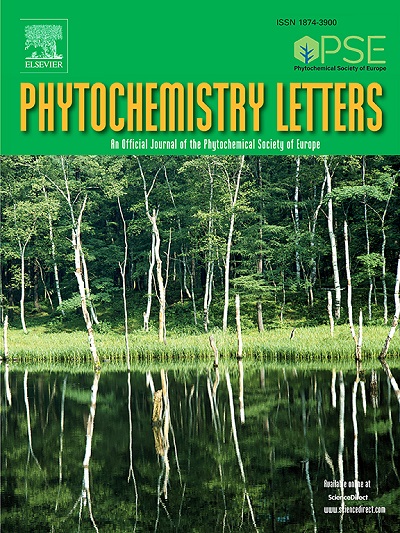Two new neo-clerodane furanoditerpenoids and other bioactive constituents from the stem bark of the Cameroonian Croton macrostachyus (Euphorbiaceae)
IF 1.4
4区 生物学
Q4 CHEMISTRY, MEDICINAL
引用次数: 0
Abstract
In our continued search for potent bioactive agents with antiplasmodial activity from Cameroonian Croton species to roll back malaria, we undertook the chemical investigation of the stem bark of C. macrostachyus, a medicinal plant widely used in folk medicine to treat several diseases including malarial. Two previously undescribed neo-clerodane furanoditerpenoids named crotomaclerodane (1) and macrostaclerodane (2) along with 11 known compounds (3–13) were isolated from the methanol extract of the stem bark of C. macrostachyus. The structures of these compounds were characterized by spectroscopic (1D and 2D NMR) analyses, HRESIMS, and single-crystal X-ray diffraction techniques. The crude extract, fractions and isolated compounds were assessed in vitro for their antiplasmodial activity towards the chloroquine-sensitive (3D7) and the multidrug-resistant (Dd2) strains of Plasmodium falciparum. In addition, the antibacterial activity was also performed against some Gram-positive and Gram-negative strains. The results showed that neither the crude extract, nor the fractions were active towards both strains. Nevertheless, compounds 4, 6, 7, and 13 showed good to moderate in vitro antiplasmodial activity with IC50 values ranging from 8.40 ![]() 51.39 µg/mL against the two tested strains of Plasmodium falciparum. Furthermore, compound 9 showed good to moderate antibacterial activity on Klebsiella pneumonia clinical isolate, Pseudomonas aeruginosa HM801, Staphylococcus aureus 700698, S. aureus 12600 with MIC values ranging from 7.8
51.39 µg/mL against the two tested strains of Plasmodium falciparum. Furthermore, compound 9 showed good to moderate antibacterial activity on Klebsiella pneumonia clinical isolate, Pseudomonas aeruginosa HM801, Staphylococcus aureus 700698, S. aureus 12600 with MIC values ranging from 7.8![]() 250 µg/mL.
250 µg/mL.
喀麦隆大戟科Croton macrostachyus茎皮中两个新氯烷呋喃二萜及其活性成分
为了继续寻找具有抗疟原虫活性的喀麦隆巴豆类抗疟疾生物活性药物,我们对C. macrostachyus的茎皮进行了化学研究,C. macrostachyus是一种广泛用于民间医学治疗包括疟疾在内的几种疾病的药用植物。从巨竹茎皮的甲醇提取物中分离得到了两个已知的新氯烷呋喃二萜,分别为crotomaclerodane(1)和macrostacachyane(2),以及11个已知的化合物(3-13)。这些化合物的结构通过光谱(1D和2D NMR)分析、hresms和单晶x射线衍射技术进行了表征。体外测定粗提物、馏分和分离化合物对氯喹敏感(3D7)和多重耐药(Dd2)恶性疟原虫的抗疟原虫活性。此外,还对部分革兰氏阳性和革兰氏阴性菌株进行了抑菌活性测定。结果表明,粗提物和馏分对两种菌株均无活性。然而,化合物4、6、7和13对两株恶性疟原虫表现出良好至中等的体外抗疟原虫活性,IC50值为8.40 51.39 µg/mL。化合物9对肺炎克雷伯菌临床分离株、铜绿假单胞菌HM801、金黄色葡萄球菌700698、金黄色葡萄球菌12600的MIC值为7.8250 µg/mL,具有良好至中等抑菌活性。
本文章由计算机程序翻译,如有差异,请以英文原文为准。
求助全文
约1分钟内获得全文
求助全文
来源期刊

Phytochemistry Letters
生物-生化与分子生物学
CiteScore
3.00
自引率
11.80%
发文量
190
审稿时长
34 days
期刊介绍:
Phytochemistry Letters invites rapid communications on all aspects of natural product research including:
• Structural elucidation of natural products
• Analytical evaluation of herbal medicines
• Clinical efficacy, safety and pharmacovigilance of herbal medicines
• Natural product biosynthesis
• Natural product synthesis and chemical modification
• Natural product metabolism
• Chemical ecology
• Biotechnology
• Bioassay-guided isolation
• Pharmacognosy
• Pharmacology of natural products
• Metabolomics
• Ethnobotany and traditional usage
• Genetics of natural products
Manuscripts that detail the isolation of just one new compound are not substantial enough to be sent out of review and are out of scope. Furthermore, where pharmacology has been performed on one new compound to increase the amount of novel data, the pharmacology must be substantial and/or related to the medicinal use of the producing organism.
 求助内容:
求助内容: 应助结果提醒方式:
应助结果提醒方式:


